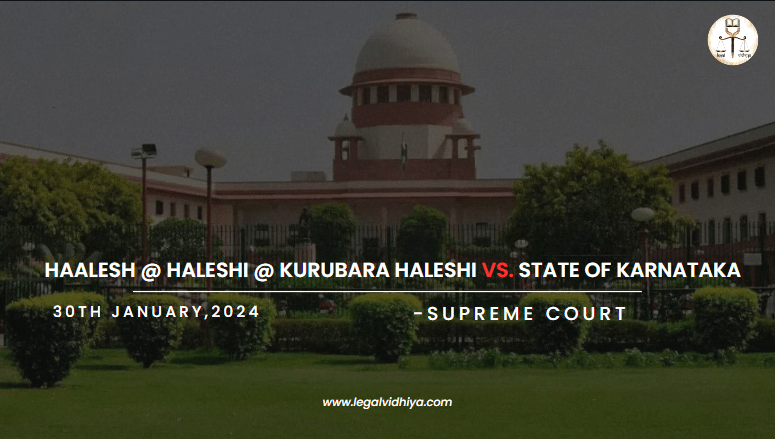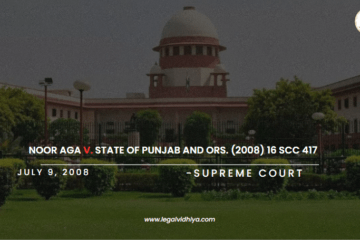
| CITATION | |
| DATE OF JUDGMENT | 2 Feb 2024 |
| COURT | Supreme Court |
| APPELLANT | Haleshi Kurubara |
| RESPONDENT | State of Karnataka |
| BENCH | K L Manjunath |
INTRODUCTION
The case of Haalesh @ Haleshi @ Kurubara Haleshi vs. State of Karnataka this case involves a sour family dispute over property among the deceased, Shivanna, and his brother, Ramanna, resulting in a sad incident of violence. On September 25, 1999, a group of individuals, along with the appellants, unlawfully assembled with the reason to kill Shivanna and his family members. Armed with lethal guns, they trespassed into Shivanna’s house, ensuing in deadly accidents to Shivanna and assaults on his wife and daughter. Following a trial, seven accused people have been convicted and sentenced, at the same time as others had been acquitted. The appellants contested their convictions, arguing that simplest the ones directly concerned in the attacks ought to be convicted underneath Section 302 of the Indian Penal Code. The prosecution relied on the testimony of injured eyewitnesses, usually Shivanna’s wife and daughter, to stable the convictions. This case highlights the complexities of familial disputes and the tragic consequences which can take place, with justice in the long run being served based on the provided evidence and prison consideration.
FACTS OF THE CASE
- The case revolves round a bitter assets dispute among Shivanna and his brother, Ramanna, which led to heightened tensions within the family.
- On September 25, 1999, all of the accused individuals accrued unlawfully in the front of Shivanna’s residence with the shared goal of killing Shivanna and his circle of relatives.
- Armed with deadly guns, in general choppers, the accused trespassed into Shivanna’s house, indicating premeditated and coordinated violence.
- Different accused individuals had unique roles inside the violent incident. A-1 to A-3 directly assaulted Shivanna, even as A-four and A-5 attacked Shivanna’s wife, and A-6 and A-7 targeted Shivanna’s daughter. A-8 and A-nine stood protect at the door, encouraging and facilitating the attack.
- Seven accused individuals (A-1 to A-7) had been convicted and sentenced to imprisonment, on the whole for homicide below Section 302 of the Indian Penal Code. However, A-8 and A-nine had been acquitted due to lack of proof implicating them within the direct attack.
- Appeals were filed by way of numerous accused people, which have been clubbed together for a joint hearing. The appellants contested their convictions, arguing towards the applicability of Section 302 IPC to all accused individuals based totally on the prosecution’s case focusing specially on A-1 to A-3.
ISSUES RAISED
- Whether the accused unlawfully assembled with the not unusual item of killing Shivanna and his relative’s individuals?
- Whether every accused had devoted overt acts to Shivanna’s loss of life?
- Whether the convictions have been based on enough evidence and whether or not the decreased courts’ findings have been perverse?
- The Supreme Court reiterated the precept of appellate restraint, emphasizing the absence of perversity inside the decreased courts’ findings?
CONTENTIONS OF APPELLANT
- The appellants argue that only accused A-1 to A-3 without delay assaulted the deceased Shivanna, even as the appellants’ roles had been constrained to moves towards Shivanna’s spouse and daughter. Therefore, they cannot be convicted underneath Section 302 IPC for murder.
- The appellants contend that they had been now not assigned precise roles inside the attack on Shivanna, and for that reason, the precept of not unusual intention below Section 149 IPC cannot be implemented to them.
- The appellants argue that there may be no direct evidence implicating them inside the attack on Shivanna. The conviction more often than not is predicated at the testimony of injured eyewitnesses, which can be subjective and motivated via emotional trauma.
- The appellants question the prosecution’s announcement of a clear reason, arguing that the belongings dispute on my own does no longer sufficiently establish intent to commit murder.
- The appellants assignment the reliability of the eyewitness testimony, highlighting ability inconsistencies or discrepancies in their accounts.
CONTENTIONS OF RESPONDENT
- The prosecution asserts that each one accused individuals unlawfully assembled with the commonplace objective of killing Shivanna and his circle of relatives, accordingly invoking Section 149 IPC, which holds each member of an unlawful meeting answerable for offenses devoted in pursuit of the commonplace item.
- The prosecution highlights the consistency and corroborative nature of the eyewitness testimony supplied by using PW-3, PW-4, and PW-7. Their money owed set up the sequence of occasions and the active participation of all accused people.
- The prosecution argues that the belongings dispute served as a clear motive for the assault, supported with the aid of the civil in shape and next execution lawsuits initiated by means of Shivanna in opposition to accused A-nine.
- The prosecution contends that the moves of all accused people, consisting of the appellants, display a shared intent to kill, as evidenced through their armed assembly and next attack on Shivanna and his own family individuals.
- The prosecution reaffirms the legal basis for convicting the appellants under Section 302 IPC in resource with Section 149 IPC, emphasizing the principle of joint prison obligation in unlawful assemblies.
JUDGMENT
In this situation, the Supreme Court heard Criminal Appeal No. 1954 of 2012 filed with the useful resource of accused A-7, Criminal Appeal No. 1955 of 2012 filed through way of accused A-4 and A-5, and Criminal Appeal No. 1303 of 2014 filed via accused A-6, all of that have been clubbed together. The appellants contested their convictions bobbing up from Sessions Case No. 25 of 2000, in which seven accused (A-1 to A-7) have been convicted for various offences related to the illegal meeting and attack, whilst two accused (A-8 and A-9) have been acquitted. The historical past discovered a sour assets dispute most of the deceased, Shivanna, and his brother, Ramanna (A-9), which led to escalating tensions. On September 25, 1999, the accused unlawfully assembled with the motive to kill Shivanna and his circle of relatives, armed with lethal guns, and trespassed into Shivanna’s house. Different accused people were assigned roles in assaulting Shivanna, his wife, and daughter, at the same time as others stood defend. The courtroom tested the proof, which includes testimony from injured eyewitnesses, PW-three (Shivanna’s spouse), PW-4 (Shivanna’s daughter), and PW-7 (Rukmini, another daughter), in conjunction with the postmortem file through Dr. Umadevi (PW-18). Despite the arguments presented by means of the appellants’ counsel regarding unique roles within the attack and the software of Section 149 IPC, the court docket affirmed the convictions. The court found that everyone accused individuals unlawfully assembled with the commonplace reason to get rid of Shivanna and his family. Even though only some at once assaulted Shivanna, all had been determined culpable beneath Section 149 IPC for their collective reason. The courtroom brushed off the appellants’ contentions concerning medical proof discrepancies and lack of benefit inside the trial courtroom’s findings. Consequently, the Supreme Court upheld the judgments and orders of the decrease courts, dismissing all 3 appeals as without substance. The bail bonds of the appellants had been cancelled, and that they were directed to surrender forthwith to serve the closing sentence.
ANALYSIS
The case includes the conviction of 4 appellants (A-4, A-5, A-6, and A-7) for his or her roles in a violent attack resulting inside the death of Shivanna and injuries to his wife and daughter. Stemming from a property dispute among Shivanna and his brother Ramanna, tensions escalated mainly to the fatal incident on September 25, 1999. Despite A-1 to A-3 directly assaulting Shivanna, the prosecution argued that each one accused, inclusive of folks that did no longer inflict physical damage, unlawfully assembled with the reason to kill. Eyewitness testimony from Shivanna’s spouse and daughter, corroborated by means of other evidence, supported the conviction. The court docket affirmed that every one accused fashioned an illegal assembly with a commonplace objective, invoking Section 149 IPC. The medical evidence, while suggesting possible variations inside the weapons used, did not undermine the eyewitness accounts. The appellate courtroom located no perversity within the lower courts’ findings and upheld the convictions, dismissing all 3 appeals. The appellants have been ordered to surrender and serve their remaining sentences, highlighting the court’s dedication to justice and accountability in instances of grave violence stemming from own family disputes
CONCLUSION
In the end, the appeals added forth through the appellants A-4, A-5, A-6, and A-7 had been thoroughly tested in light of the evidence and prison concepts supplied. The case stemmed from a sour property dispute and a sad incident of violence, resulting within the dying of Shivanna and grievous accidents to his spouse and daughter. While the appellants contended that most effective unique individuals directly involved inside the attack must be convicted, the courts upheld their convictions based on the doctrine of not unusual aim under Section 149 IPC. The eyewitness testimonies of Shivanna’s wife and daughter, corroborated by way of additional evidence, proved vital in establishing the culpability of all accused individuals. Despite attempts to challenge the medical evidence, the courts located the ocular evidence to be compelling and sufficient for conviction. Given the absence of any obvious perversity within the decreased courts’ findings and the thorough consideration of all cloth evidence, the appeals had been dismissed. Consequently, the appellants are directed to surrender and serve the rest in their sentences. This verdict underscores the judiciary’s commitment to upholding justice, especially in cases of heinous crimes springing up from their own family disputes.
References
- SCC Online
- https://www.advocatekhoj.com/library/judgments/announcement.php?WID=17227
- https://indiankanoon.org/doc/81677999/
By- Sheetal Bhadoriya, SYMBIOSIS LAW SCHOOL, HYDERABAD, Intern at Legal Vidhya
Disclaimer: The materials provided herein are intended solely for informational purposes. Accessing or using the site or the materials does not establish an attorney-client relationship. The information presented on this site is not to be construed as legal or professional advice, and it should not be relied upon for such purposes or used as a substitute for advice from a licensed attorney in your state. Additionally, the viewpoint presented by the author is of a personal nature.




0 Comments